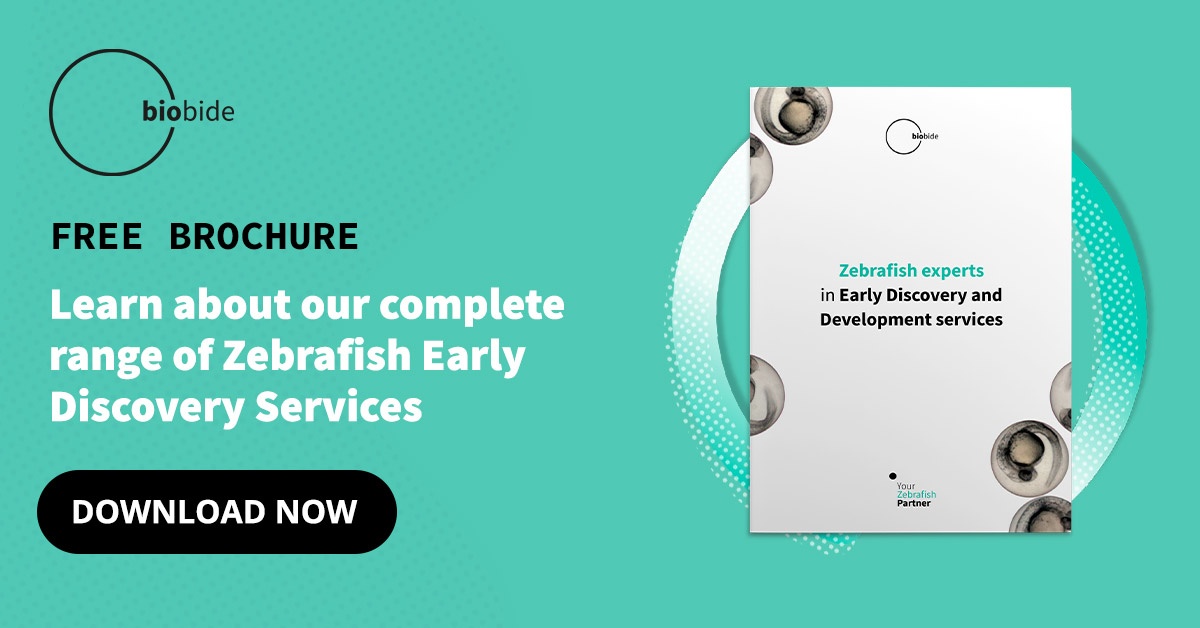Drug Discovery and Development is a long process that goes through several phases, often taking over a decade. The process includes different in vitro and in vivo studies that allow us to study the efficacy and toxicity of the potential drug.
One of these studies is the in vivo test. In vivo testing whole models to verify the efficacy or toxicity of a drug that is expected to be launched in the pharmaceutical market.
In this article, we will explain what an in vivo test is, how it works, and how it differs from other tests. We will also discuss how Zebrafish can be utilized for in vivo testing and their significance.
What is an In Vivo Test?
In vivo means "within the living", so it makes sense that an in vivo test is one that is performed within the body of a living model. In vivo models can include animals as well as rodents, rabbits, or other complex mammals.
This is an essential process for Drug Discovery, as it clearly reflects the effect of the different compounds on a complete and complex organisms such as animals.
The reason that in vivo tests are performed on these models is because they have a high genetic similarity with humans, maintaining most of the biological routes and also, includes the complexity of the whole animal which is lost in in vitro studies so the effects are translatable. However, are there is a growing push from different organizations and governing bodies to move away from animal testing following the 3Rs principle, new alternative models are being increasingly used to conduct in vivo tests. Later in this article we will examine how Zebrafish are revolutionizing preclinical and practical in vivo studies.
How Is In Vivo Testing Different From Others?
Now that we know what an in vivo test is, let's examine how they differentiate from other test options. There are different types of tests that can be used for Drug Discovery, including in vitro testing.
In vitro studies are those that are performed outside of a living organism. Traditionally they are considered more economic compared to in vivo tests.
Although in vitro tests do not imply large costs, they are not always the right test for your needs. 30% of them fail in clinical trials, which can impede productivity and add up in costs later. In vitro tests help to identify reactions that can become toxic or carcinogenic.
However, in vivo and in vitro tests can be complementary in some cases, depending on the application. Let’s take a look at some of the advantages of each option:
Advantages of In Vivo Testing
In vivo testing can be a good option for some of the following reasons:
- They last a long time, and are likely to produce better results.
- Preclinical studies performed in animals allow more translatable results for humans.
Advantages of the In Vitro test
For their part, in vitro tests stand out because:
- They are less expensive and have a large-scale scope.
- They have the approval of organizations that defend animal rights, as they are carried out externally.
As you can see, preclinical studies in animals is a sensitive subject, so other forms of study have been discovered that reduce the number of animals in laboratories and that, even, become more efficient during the process. These types of studies can be done while respecting the 3Rs principles.
What Are Zebrafish And How Are They Related To In Vivo Testing?
To reduce the use of rodents, rabbits, and mammals in laboratories, and to follow 3Rs guidelines, scientists have turned to zebrafish, which is an animal whose anatomy favors some preclinical studies, such as in vivo testing.
These fish serve as bridges between in vitro and in vivo tests and, compared to some rodents, are adaptable to various conditions and environments. This means that they are profitable in terms of housing, maintenance and reproduction, as females lay up to 200 eggs, which, due to their size, are easy to store.
The embryos of these fish are so transparent that they allow the effects of each drug to be observed in detail. On the other hand, these embryos are fertilized and developed externally, making some tests such as phenotypic easier.
Another great advantage is that they share 80% of the genome with humans, which also allows us to easily verify the efficacy or toxicity of a drug and its extrapolation for human consumption.
How are Zebrafish different from other laboratory animals?
In addition to the above, the embryos of a zebrafish are not considered as animals until they are six or seven days old, which is when they can feed independently.
If we see this from an ethical point of view in terms of animal rights, in vivo tests are more acceptable when applied to these beings and not to other animals such as rodents, as they are not subject to stress and other types of suffering.
It is for all this that zebrafish are mentioned as the main reference of the 3R Principle, referring to the Replacement, Reduction and Refinement of animals that are the subject of preclinical studies in the world of pharmaceuticals.
With all this, in vivo tests are no longer the target of criticism, as they promote the welfare of animals in general without reducing or minimizing scientific advances in pharmaceuticals. Without a doubt, a great advance that balances the well-being of humans and animals.






